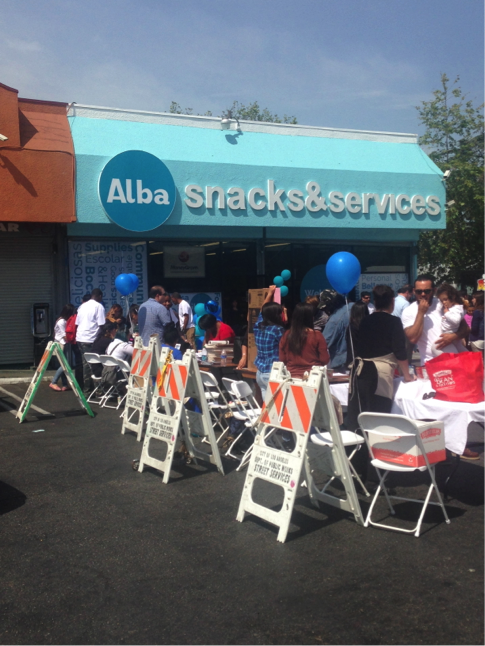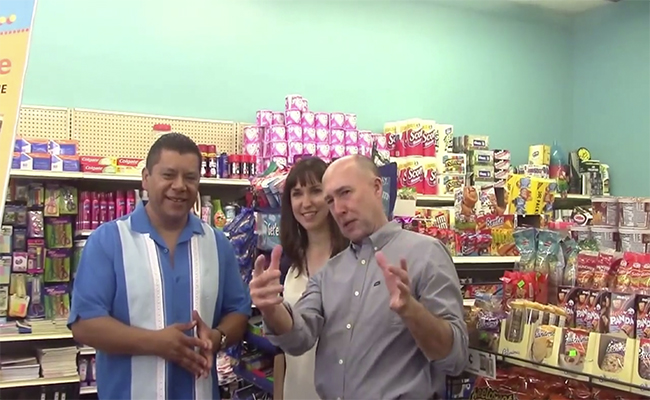When more than 100 children, teenagers and adults gathered on the corner of Vermont and 60th streets last March to enjoy a four-hour block party complete with face painting, booths offering food coupons and a live disc jockey encouraging people of all ages to dance by blasting R&B, rap and Latino music, onlookers may have assumed the occasion was a national holiday or neighborhood fundraiser. Instead, the festivities were meant to mark the re-opening of Alba Snacks & Services, one of South L.A.’s few grocery stores.
The approximately 51 square mile area of South Los Angeles is largely considered a “food desert” — a space where finding food that is both affordable and high-quality is difficult.
See also on Intersections: South LA creates healthy food options
The Alba re-opening was part of the Healthy Neighborhood Market Network and the Community Market Conversion Program, an initiative run by Los Angeles’s Food Policy Council, an independent multi-stakeholder entity of the Mayor’s Office. These dual programs, said Director of Policy and Innovation Clare Fox, aim to transform convenience stores in neighborhoods with limited food access to full-service grocery stores.
“Unfortunately here in the city of L.A., the neighborhood that you grow up in and the food that you have access to impacts how healthy you are,” Fox said, explaining her group’s motivation.
The program’s goal is to create oases where stores are willing to dedicate at least 50 percent of their inventories to selling a wide-range of fresh fruits, vegetables and meats along with dairy products and canned foods.
Fox also said locals need to buy in to the philosophy of the new stores – literally. “If you want to see healthy food in this market, you have to come over and buy it,” Fox said.
In the past year, two large grocery stores, both Ralph’s supermarkets, closed in South L.A. A location at Rodeo Road and Crenshaw Blvd closed on May 20, while a second on the corner of Martin Luther King Boulevard and Western Avenue closed June 21.
The idea of bringing additional fresh produce to existing grocery stores dates to the early 1990s. According to the Community Health Councils, in 1995 Ralph’s was among a group of retailers that committed to building as many as 32 South L.A. stores in the wake of the 1992 civil unrest following the Rodney King verdict. The violence of the riots decimated many stores in the area.
The food desert phenomenon has meant that full-service markets are out of reach for South L.A. residents without cars or funds to cover gas driving back and forth to stores elsewhere.
Another barrier in accessing healthy food items is the expense. Roughly 248,948 people use CalFresh cards, formerly known as food stamps, when shopping in South L.A. This number is greater than the 38,199 individuals living in West Los Angeles that receive CalFresh, according to a December 2013 report from the County of Los Angeles Department of Public Social Services.
Furthermore, among the 13 markets in the area that accept Electronic Benefit Transfer, another kind of food stamp program, according to the California EBT Client website, only two large stores offer fresh food options — Albertson’s and Wal-Mart. In West Los Angeles, there are three Ralph’s and one Whole Foods accepting EBT.

Alba Snacks & Services debuted its renovations on Mar. 30 with community activities, healthy food and smoothie samples. Local politicians, high school students and families attended. | Jordyn Holman
Because of the dearth of full-service markets in the area, Nelson Garcia, the owner of Alba Snacks & Services, recognized the need to bring more fresh yet affordable food options to residents. Garcia said that he believed he could bring that positive change to the landscape of South L.A. businesses.
“I’m interested in offering more options for the students and residents in the community,” Garcia said, “so they can chose to have healthier foods to live with.”
In South L.A., obesity and diabetes rates are among the highest in Los Angeles County. According to a 2011 Los Angeles County Health Survey, 11.7 percent of adults in South L.A. live with diabetes, compared to 5.2 percent in the more affluent area of West L.A. Obesity rates are also high, with 32.7 percent of the adults considered obese compared to 9.8 percent in West L.A.
Garcia’s store must still complete several more steps to transition into a full-service grocery store. Right now, the store offers several options of fresh fruit, such as bananas and oranges, and healthy snack foods like applesauce.
Fox from the Food Council said Garcia will eventually add more fresh produce as well as a stock of student supplies, a computer lab and a remittance service where people can transfer money to their home countries. These next steps will be financed by a microloan that was acquired through crowdsourcing in addition to out-of-pocket payments from Garcia, according to the Food Council.
The Community Market Conversion Program has also taken root in other cities, including New York City and San Francisco, with the help of private funding. Within South L.A., other grocery stores are being built and farmers’ markets are being established to fill the void in fresh food options.
The Juanita Tate Marketplace opened on the corner of Slauson and Central avenues in early April. It is the only center in the area to feature both a grocery and a drug store, according to the site for the company that owns the new center, Regency Center.
Furthermore, the weekly farmers’ market at Baldwin Hills Crenshaw Mall, which kicked off in November, increases the number of places where South L.A. residents can purchase fresh fruits, vegetables and other snacks.
Even with the assistance of the conversion program, Alba Snacks & Services might still face several challenges as it moves forward, particularly in attracting and retaining regular patrons.
Tony Terry, the principal at Augustus F. Hawkins High School two blocks from the new grocery store, attended the opening ceremony. Terry said the roughly 1400 students at the high school could become regular store customers.
“I hope the students understand who Nelson is and the commitment he has made to the community and that they honor that and support it,” Terry said. “These kids have spending money and hopefully they won’t go over to the corner store, but instead come here.”
Others invested in South L.A. communities hope to use the conversions of corner stores as a springboard for other revitalizations here. Councilman Curren Price of South L.A.’s District 9 said he was invested in bringing more full-service grocery stores to the area.
“The Ninth District is open for business,” Price told the crowd that gathered for the grocery store’s reopening. “But we’re not open for business as usual. We expect to have the quality goods and services that are offered in other parts of the city.”
Alba Snacks & Services
6001 S. Vermont Ave, Los Angeles 90044
















Awesome can’t wait to see the complete renovation of Alba! I will support whenever I am in the area.
I don’t get it. The corner of Vermont & Slauson, not even 1/4 mile from Vermont & 60th, has both Superior and El Super grocery stores. A couple of blocks away (about 1/2 mile according to Google Maps) there are Food4Less superstores at Main & 54th, and at Western & 59th.
These stores offer fantastic selections of meat and fresh produce at rock bottom prices. The article claims a 51-square-mile food desert; that’s a square more than 7 miles on each side. Where is this desert? Clearly not anywhere near Vermont & 60th.
RickRussellTX, I think you miss the point. No offense but, El Super, Superior and Food4Less are not high quality retailers, nor is their assortment of meats and produce fantastic. Have you shopped there yourself? Sounds like you might have let Google Maps determine the food landscape of this area for you, if you actually visited these retailers yourself you might understand why concerned citizens want access to options of superior quality than what is currently being offered. The term Food Desert is used to infer that there is a disparity between what is offered at local retailers in areas where markets like Food4Less are prevalent, as opposed to areas where residents have the option to shop at co-ops or retailers like Whole Foods and Gelsons, who offer premium quality meats and produce, among other health inspired options. We’re not so concerned about rock bottom prices. We know we are being offered cheap food, that’s not what we are seeking. We want access to fresh, healthy, high quality, non-gmo, affordable, local, sustainable and nutrient-rich food, as residents on the westside are afforded. Now do you get it?